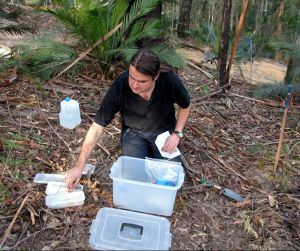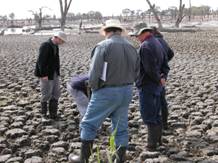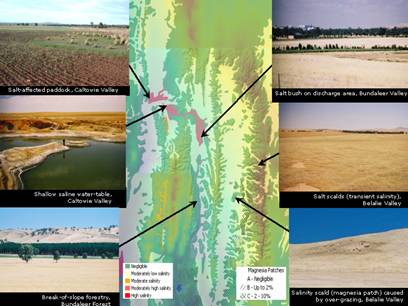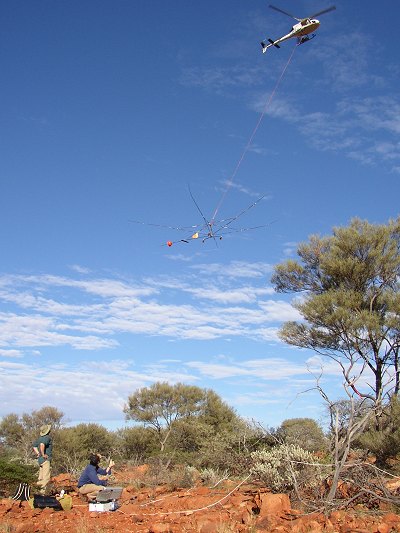RESEARCH UPDATES
PROGRAMS 3 AND 4
P3 - ENVIRONMENTAL APPLICATION OF REGOLITH SCIENCE AND
P4 - SALINITY MAPPING AND HAZARD ASSESSMENT
[Research Updates on Program 1 (Regolith Geoscience) and Program 2 (Mineral Exploration in Areas of Cover]
April 2008
INLAND ACID SULFATE SOIL SYSTEMS ACROSS AUSTRALIA.
Thematic Volume close to completion.
Editors: RW Fitzpatrick and P Shand
Covering distribution, properties, significance and biogeochemical processes of inland Acid Sulfate Soils (ASS) across Australia and overseas (Iraq and Brunei). 30 Australian and 2 overseas case histories will be incorporated in this volume.
See brochure for more information. Enquires to LEME Head Office
March 2008
Major LEME presence at 2nd International Salinity Forum, presentations, booth, posters, workshops.
July 2007
LEME Paper voted one of best four at SAGEEP
Andrew Fitzpatrick's paper "Mapping Salt-loads of the Murray River, Australia, using airborne and in-river electromagnetic methods" was one of the best at the Symposium on the Application of Geophysics to Engineering and Environmental Problems, held April 07 in Denver, Colardo. Andrew is from CSIRO Exploration and Mining and his attendance was co-sponsored by CSIRO and LEME.
It is very encouraging to see LEME science getting recognition on the international stage which reflects well on the Program 4 team's work. Andrew has been invoted to present the same paper at the Near Surface 2007, 13th Eurpopean Meeting of Environmental and Engineering Geophysics Conference, Sept 07.
Download Abstract. Symposium Proceedings available from:
http://www.eegs.org/pdf_files/publication_order_form.pdf
LEME researchers feature in ASSAY No. 42, June 07
Article "Sulphidic sediments in inland Systems - the Loveday Basin" Sue Welch, Sara Beavis, Luke Wallace and Paul Shand (Australian National University). Page 7.
Our Rob Fitzpatrick from CSIRO Land and Water, an expert on Acid Sulfate Soils, presented at a number of forums held in Tasmania. Story on front page.
Download Assay Newsletter.
June 2007
Focus on Salt Issue 41 - June 2007
Articles "Aerial technology to give Sunraysia a clearer salinity picture"- Greg Lawrence, and "Insight into acid drain geochemistry" - Rob Fitzpatrick.
Download
- Focus On Salt - 41
March 2007
Focus on Salt Issue 40 - March 07
Article "What's all the stink about" - a guide to sulfur gas emission in Australian wetlands and disposal basis, and release of LEME Open File Report 208 - author Sebastien Lamontage.
Download
- Focus on Salt
- Article by Greg Lawrence (Page 16-17)
- OFR 208 - A Guide to Sulfur Gas Emissions from Wetland and Disposal Basins: Implications for Salinity Management.
December 2006
November 2006
Release of Regolith 2006: Consolidation and Dispersion of Ideas. Proceedings of the CRC LEME Regolith Symposium, November 2006. Hard Copy Volume available to purchase - 385 pages and 93 extended abstracts. Also individual Abstracts available to download.
October 2006
LEME Researcher and former PhD Student - DR FRANK REITH WINS THE ROBERT HILL MEMORIAL PRIZE FOR 2006. Awarded by the Research School of Earth Sciences, ANU.

Frank was selected from five nominees who were required to present a brief research seminar as part of the assessment process. The nominating letters, CVs and presentations were judged by the ANU Committee against the selection criteria: Execllence in research - Proven publication record - Links to research in other disciplines - Good communication skills - Ability to communicate research to a broad audience.
(Photo- Frank Reith catching bugs)
Frank's research on the biomineralisation of gold led to the discovery of a bacteria that precipitates gold out of solution. His work was published in the prestigious journal Science in July. Since then, his research has been reported in many science journals and newspapers around the world.
The award is made each year to honour the memory of a young ANU researcher renowned for his ability to talk publicly about science who died suddenly in the early nineties.
September 2006
First issue (Sept 06) of LEME NRM Brief - Regolith Sciences in Natural Resource Management. A short newletter circulated per email. Download PDF file
- Balloon photography allows scientists to get a bird's eye view (high resolution aerial imagery or regional features)
- Petroleum exploration technology searches for groundwater
- Online information for central Qld NRM managers now available
- Airborne geophysics plays an important role in assessing salinity risk along Murray River floodplains
- Acid sulfate soil identification kit developed for Loxton
Contact crcleme-hq@csiro.au to be included on our e-mailing list
FOCUS ON SALT
Issue 38 - Sept 06. published by CRC for Plant Based Management of Dryland Salinity in collaboration with CRC LEME. Download PDF (1.24MB)
LEME articles:
Page 8-9. Loveday Basin restoration underway
Page 10. New Program 3 Leader - CRC LEME - Dr Paul Shand
July 2006
Media Release ex Australian Earth Sciences Convention - Melbourne
Airborne Geophysics to help reduce Murray River Salinity
Download .PDF Release
Contact Dr Tim Munday for more information tim.munday@csiro.au
2005
- LEME was a significant contributor, particularly in terms of airborne geophysics, to the South Australian Salinity Mapping and Management Support Project. Reports and results are now available on the SA DLWBC Web site. A number of LEME Open File Reports have been released in relation to the Project. They are OFR Nos 171 to 179 and can be viewed or downloaded as .pdf under our Publications - OFR Index Section. Enquiries to Tim Munday, CRC LEME.
- WA Wheatbelt drainage - acidic groundwater, not just a salt issue. Author - Steve Rogers - CRC LEME. Article from June 05 edition of "Focus on Salt".
- In the West Australian Wheatbelt Steve Rogers and Rob Fitzpatrick (CLW Adelaide ), David Gray, and Mark Pirlo (CEM Perth) are studying the trace element geochemistry of acid saline waters in salinity mitigation drains. They have shown that trace elements and rare earth minerals are present in highly elevated concentrations exceeding Australian water quality guidelines. The outcomes of this work will have a major impact on drain design and management of drain water receiving environments. (posted 21.4.05)

Photo: Low pH trace element rich drainage waters WA Wheatbelt
- At the Loveday Basin wetland adjacent to the River Murray, Sebastien Lamontangne, Steve Rogers, and Rob Fitzpatrick (CLW Adelaide) and Warren Hicks (CLW Canberra) are studying the mineral and trace element geochemistry of sulfidic sediments, that have the potential to oxidise and produce sulfuric acid. The work is assisting land managers and state NRM agencies in developing appropriate remediation options for River Murray wetland systems (posted 21.4.05).

Photo: CRC LEME, Department of Water, Land & Biodiversity Conservation SA joint field visit Loveday Basin Lower River Murray
- Jim Cox, Michael Durkey, Chris Smit and Phil Davies (CLW Adelaide) have assessed the effects of a shallow groundwater drain through the Bald Hill Flats (part of the Upper SE, South Australia drainage program) and suggest it will be very effective at lowering the water-tables, provided certain regolith constraints are met. (posted 21.4.05)
- Richard Cresswell (CLW Brisbane) has found that vertical mobility of salts is more important in defining salinity outbreaks in the Hodgson Creek Catchment (Queensland MDB) than is lateral groundwater movement. (posted 21.4.05)
- John Dighton (CLW, Adelaide ) has developed a novel, yet simple method for routine d 34 S measurements on water and high-sulphur minerals. (posted 21.4.05)
- Richard Cresswell (CLW Brisbane) and Andrew Herczeg (CLW Adelaide) have combined airborne geophysics, hydrogeochemistry and hydrogeology to define recharge and aquifer parameters across 3 NAPSWQ focus catchments ( Upper Broughton [figure below] Angas-Bremer, SA and Lower Balonne, Queensland ) and explain how and where salinity is expressed. (posted 21.4.05)

Figure: Expressions of salinity in the Upper Broughton Catchment, SA
- Jim Cox, Chris Smitt, Andrew Herczeg, Glen Walker and Phil Davies (CLW Adelaide) joined with John Wilford (CRC LEME/GA) to realise that rainfall is the primary factor governing salt stores in the Bremer Hills, SA, while depth of weathering governs the actual amount of salt mobilised. (posted 21.4.05)

Figure: Radiometrics data from the Bremer Hills has been used to identify potential salt stores in the form of deeply weathered, clayey materials.
- Richard Cresswell (CLW Brisbane) has generated revised salt accession maps for Australia and is co-ordinating (with Andrew Herczeg and John Dighton (CLW Adelaide) the establishment of a network of rainfall collectors across the country to generate a baseline for ion accession isotope variability. (posted 21.4.05)

REGOLITH TO THE RESCUE
Innovative application of regolith science and new geophysical techniques to natural resource management in upland and lowland regions of the Murray-Darling Basin
This CRC LEME Article (PDF 480kb) refers to the Blanchetown Clay Riverland (SA) and Balonne River Inland Fan (Qld) areas. It highlights the innovative applications employed by CRC LEME teams and the National benefits arising from the research. (posted 22.4.05)
SUBMISSION FROM CRC LEME AND GEOSCIENCE AUSTRALIA
A review of salinity mapping methods in the Australian Context 2004. (Posted 28.1.05)
CONTENTS includes Executive Summary and direct links to abstracts and figures.
GEOSCIENCE ESSENTIAL IN SALINITY MANAGEMENT
Recently completed projects in South Australia and Queensland have demonstrated the value of using airborne geophysics within an integrated geoscience approach to mitigating salinity in Australia. (Posted 280105)
Article in AUSGEO News 76 (page 4) featuring LEME Program 4 project work:
South Australian projects - Riverland, Tintinara, Angas Bremer Hills, Angas Bremer Plains and Jamestown.
Queensland project - Lower Balonne.

Don Hunter (LEME PhD student) and Andrew Boyd (Rio Tinto Consultant)
watch HOISTEM system overfly a calibration loop on the ground,
Paraburdoo, WA, part of the AMIRA project P407.
|
